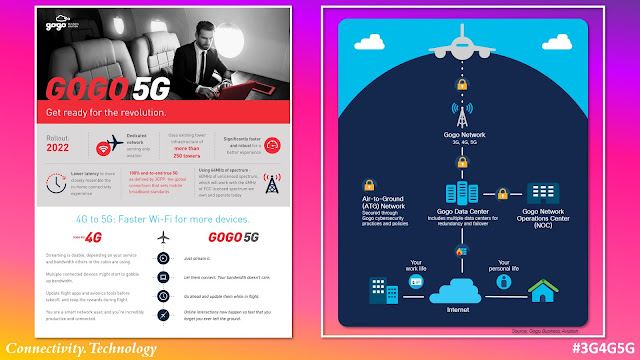We have looked at Connectivity on Planes in a tutorial before. We have also discussed Air-to-Ground (A2G) Networks for Emergency Communications. As the number of 5G devices grows, it makes sense to have 5G connectivity on the planes to be able to provide much faster speeds to the end users willing to pay the premium.
Gogo is the world's largest provider of broadband connectivity services for the business aviation market. According to their website, Gogo Business Aviation has shipped more than 17,000 systems worldwide, is a factory option at every major business aircraft manufacturer, and has solutions installed on the world’s largest fractional ownership fleets.
They also offer a customizable suite of smart cabin systems for highly integrated connectivity, inflight entertainment and voice solutions. Their products and services are installed on thousands of business aircraft of all sizes and mission types from turboprops to the largest global jets, and are utilized by the largest fractional ownership operators, charter operators, corporate flight departments and individuals.
Currently, there are more than 2,000 business aircraft flying with Gogo's AVANCE L5 or L3 system installed. As of June 30, 2021, Gogo reported 6,036 aircraft flying with its ATG systems onboard, and 4,587 aircraft with satellite connectivity installed.
Last year Gogo announced that they will bring 5G to the planes that will be able to deliver ~25 Mbps on average with peak speeds in the 75-80 Mbps range. The network is scheduled for H2 2022. The following is from the press release:
The 5G speeds above are based on modeling of eight commonly traveled city pairs, including New York, Miami, Los Angeles, San Francisco and Dallas, and confirmed by recent flight testing of Gogo's airborne and ground-station antennas.
Gogo 5G will be a fast and easy upgrade for aircraft installed with AVANCE L5, which is the most successful and widely adopted broadband connectivity system in business aviation history.
The AVANCE speeds quoted above are based on interviews with more than 70 Gogo customers by The Boston Consulting Group. Customers report regularly using video-intense applications like Zoom, Teams, and social media.
Gogo AVANCE is line-fit offerable at all nine business aviation OEMs, and has STCs across all aircraft types and sizes from personal jets (Cirrus G2+ Vision Jet) and turboprops to the largest ultra-long range global aircraft. Gogo also has a network of 120 authorized dealers worldwide.
This year Gogo ranked No. 1 in the Aviation International News (AIN) Product Support Airborne Connectivity customer satisfaction survey and has ranked first in that survey nine of the last 11 years, finishing second the other two years. This year Gogo ranked first in seven of the eight categories surveyed.
Cisco has a nice solution brief for the Gogo 5G Network for Aviation here. According to that, the Gogo 5G Network will consist of:
- Gogo - AVANCE L5 System; X3 (5G LRU); tower infrastructure
- Cisco - Ultra 5G Cloud Core and Data Center Support
- Airspan - Air5G product line including base station technology; Massive MIMO antenna arrays
- FIRST RF – Fuselage-mounted blade style multiband aircraft antennas
Airspan has a nice customer story video of Gogo 5G ATG (air-to-ground) connectivity embedded below:
In another post on Telecoms Infrastructure Blog in future, we will look at some of the infrastructure for this solution.
Related Posts:
- Connectivity Technology Blog: How does Plane Wi-Fi and Mobile Connectivity on Planes Work?
- Connectivity Technology Blog: Air-to-Ground (A2G) Network for Emergency Communications

Comments
Post a Comment